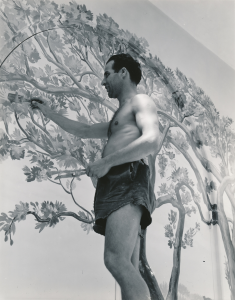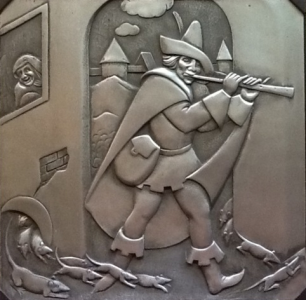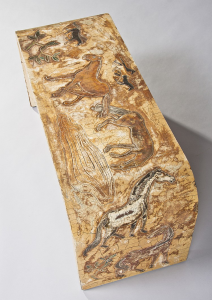
Biography
Domenico Mortellito was born in Newark, NJ, the son of a grocer. At age 8 he was apprenticed to a muralist in Venice, Italy. He returned to the United States, attended public school and sought an education in art at the Pratt Institute in Brooklyn and the Newark School of Fine and Industrial Art. He graduated from Pratt in 1922 and from the Newark School in 1926.
After graduating from the School of Fine and Industrial Art, Mortellito got a job with the architectural design firm of Mack, Jenny and Tyler in New York, where he worked until 1932. This company handled massive interior decoration projects. One example from that time period is the Great Hall of the National Academy of Sciences in Washington, DC. Working with Mack, Jenny and Tyler, Mortellito completed a number of projects, including: a frieze for the Morgan Library Annex in New York; a medallion for the curtain of the Capitol Theater in Atlanta, GA; murals for the dining room of the Brooklyn Edison Company; ceiling medallions and lunettes for Woolsley Hall at Yale University in New Haven, CT; and murals on the dome and lunettes for St. Joseph's Chapel in Brentwood, NY.
From 1932-1942 Mortellito ran his own design studio in New York. His work included decoration for public buildings, and the design of commercial displays and expositions. He painted a mural for Monroe High School in the Bronx in 1934. And, in one of his most enduring works, he designed ceramic tile murals for a number of light rail stations along the Morris Canal in Newark, NJ (1935). He completed a set of four murals and nine lunettes for the Post Chester, NY Post Office in 1936. In 1936 and 1937 he painted murals and bas reliefs for the National Zoo in Washington, DC.
In 1939 Mortellito was hired by New York City to work on the New York World's Fair. He ended up executing eight mural contracts for the Fair: a Lucite mural for the DuPont Pavilion, mixed-media murals for the Venezuela Pavilion, a troweled cement mural for the dome of the Heinz Pavilion, a chlorinated rubber paint mural for the Fisheries Building, a carved lacquered linoleum mural for the Sports Building, linoleum murals for the House of Jewels, the archway for the Ford Pavilion, and an exterior mural for the Hall of Fashion.
Aside from the sheer volume of this work, it is impressive how great a variety of media and materials Mortellito explored in this one exposition. A 1939 exhibit at the Museum of Modern Art showcased his work in carved and lacquered linoleum. And the same year his sculpture was shown at the Golden Gate Exposition in San Francisco.
During the years of World War II, Mortellito worked in the Pentagon, designing exhibits, supervising graphic presentations, and designing booklets and brochures. Postwar, in 1945, he moved to Wilmington, DE, where he became a design advisor for the DuPont Corporation. From 1950-1980 he served as DuPont's color expert, chairing the DuPont Color Council from 1957-1970. The Council worked to promote the use of DuPont dyes.
Mortellito's second World's Fair experience came in 1964, when he designed the DuPont Pavilion. In 1980 began work at the Mobay Chemical Corporation to create industrial dyes. He died in Wilmington in 1994.


Critical Analysis
Given how prominent an artist Domenico Mortellito was in the 1930s and 1940s, and given how prolific he was, it may seem puzzling that his name is not more familiar to patrons of art museums. The answer lies in the types of commissions that Mortellito accepted and the companies for which he worked. Unlike many other muralists of the 1930s Mortellito did not do a lot of easel painting, so there never was much of his work for museums to acquire. Of course a number of his murals - public and private - have survived and can be seen in their original settings, including, for example, his faience ceramic tile murals in light rail stations in Newark, NJ.
A second reason that Mortellito's work may be unfamiliar to many people is that he did a lot of work behind the scenes, working in industrial laboratories to create new dyes, and experimenting with artworks using new materials. His dyes showed up in printing processes developed by DuPont - not obvious to anyone looking at the results, but an essential step in producing these results. Mortellito worked with Lucite, nylon, Teflon and other newly developed materials - long before other artists began to experiment in these media. He even explored ideas for producing low-cost housing that could be built on-site using extruded or molded plastics.
Despite Mortellito's long association with DuPont and its associated laboratories, Mortellito was anything but a cold and remote artist. His murals for Post Chester, NY and for Newark's light rail stations along the Morris Canal are brimming with energy and life. As a boy, Mortellito rode his father's grocery cart around Newark, and the street scenes in the Port Chester mural feel as if they have been pulled right off the streets just minutes ago. Mortellito was actually criticized by city officials in Port Chester for making his murals so colorful, but that is part of what makes them still feel so alive today. Having grown up in Newark, Mortellito had swum in the Morris Canal - back when it was unpolluted - so the idea of memorializing scenes along the canal in his tile murals must have had a special personal appeal.
In addition to murals, Mortellito did illustrations and sculpture. One example of his sculpture can be found at the Delaware Art Museum in Wilmington. It is entitled "Protecting the Future" (1967) and, in keeping with the tenor of that era, dealt with the topic of environmental protection. This, too, may reflect a bit of nostalgia for the world of his boyhood.
Murals
- Washington, District of Columbia - National Zoological Park: Habitat Background
- Washington, District of Columbia - National Zoological Park: Noah's Ark
- Newark, New Jersey - Broad Street Light Rail Station: Swimming in the Morris Canal
- Newark, New Jersey - Pennsylvania Station: The Morris Canal
- Newark, New Jersey - Warren Street Light Rail Station: On the Morris Canal
- Newark, New Jersey - Washington Street Light Rail Station: Morris Canal Scene
- Bronx, New York - Monroe High Educational Campus Library: The Machine Age
- Port Chester, New York - Post Office: Occupations of Port Chester
References
- Domenico Mortellito, (Memorializing the 1939 Fair), The Queen's Museum New York World's Fair Association Issue No. 4, Fall/Winter (1990).
- Domenico Mortellito (Domenico Mortellito).
- Domenico Mortellito (askART).
- Domenico Mortellito papers (Hagley Museum and Library).
- From Etchings to Vast Murals, City Inspired Artist’s Visions (Knowing Newark).